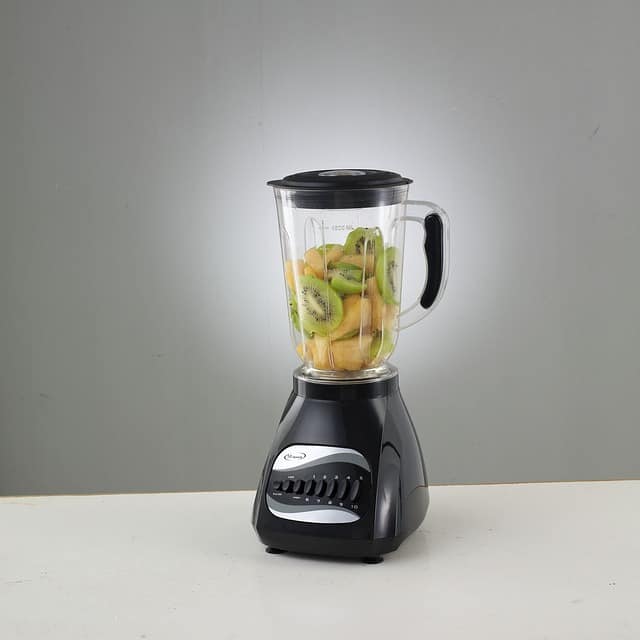Mashing potatoes in a blender or food processor is completely possible, but there’s a heavy downside to this method.
This article outlines the problems of mashing potatoes using a blender or food processor, and then gives the best alternatives for making fluffy, creamy and lump-free mashed potatoes.

Why it’s not recommended to mash potatoes in a blender
The reason why the blender isn’t recommended to be used for mashing potatoes is because of the way it works.
The blender operates electrically with small sharp blades that cut through food items and turn them into tiny particles.
When you put boiled potatoes into a blender, the same thing happens. The potatoes are cut very finely which leads to a terrible implication, especially when the end goal is to make mashed potatoes that are fluffy.
You see, potatoes contain something called starch, a lot of starch. Whenever a potato is cut open, destruction happens to the integrity of the starch molecules, the extent to which depends on how finely the potatoes are hit or cut by the blades.
In methods using low effort and aggression, such as the ricer or hand masher methods, a lot of the potato starch molecules are left intact and therefore the potatoes give a fluffy consistency.
Using a blender on the other hand means that a good number of the starch molecules would be torn across, which allows them to mix with the liquids of the medium such as broth or milk and develop a gummy paste.
That’s why mashed potatoes made with blenders have a gummy consistency.
For those that are familiar with the popular West African recipe called “poundo yam”, the same principle is what gives the yam its consistency, except this time the medium isnt a blender but mortar and pestle.
In the beginning, when the pieces of yam are stuffed into the mortar and hit a couple of times, they pick up a fluffy consistency reminiscent of mashed potatoes, but you’ll notice at that time that they have lots of lumps in them.
As the yam is pounded more and more, and water added in little quantity, it begins to turn into a gummy substance, and the reason why is because more starch molecules are actually torn, and these get to mix with the water to form the stretchy paste.
The same is the case with a food processor
The food processor works in a similar fashion to a blender i.e. to cut food particles into finer, smaller particles. Because of this, it is also quite easy to turn mashed potatoes into a gummy paste after processing them in a food processor.
Now you might think it should be possible to hit potatoes (in either the blender or food processor) at intermittent burst, in order to arrive at the right consistency which is fluffy, but the problem here is that it’s almost impossible to hit the sweet spot where the potatoes are lump free and at the same time not gummy. It’s just difficult. Either you end up over hitting the potatoes in the processor or under mashing them. In either case, you get a result that isn’t satisfying for a mashed potato.
The best ways to mash a potato
Ricer
A ricer is a handheld tool meant for processing soft food items into strings. This method is by far the best way to mash potatoes, because it produces potatoes that are free from lumps, which are quite annoying to chew on to be honest.
With a ricer, all you have to do is stuff the potatoes into the hopper and then force them out through the tiny perforations by pressing on the handles.
The fact that the potatoes are forced through perforations, means that lump isn’t given a chance to form and therefore mashed potatoes come out super fluffy and when coated with dairy of choice, creamy.
Afterwards, you can add the liquids of the recipe to the mashed potatoes and incorporate really gently. Make sure to really incorporate gently as going hard would easily transition the potatoes into a gummy paste: remember the harder you work potatoes, the more starch is released and the more gummy it turns as the starch gets coated with the liquid of the medium.
Mixer: Handheld or Stand
For mixers, there are two varieties, the one you hold to mix items yourself, and the one that is fixed in a position in the kitchen. Many people prefer the hand held mixer for mashing potatoes because of its extra flexibility, but the stand mixer would do a perfect job most of the time too.
With the mixer, you would be able to create potatoes that are light and fluffy, but would have a little bit of lumps here and there. Trying to hit out of these lumps however, can easily lead you to overwork the potatoes and cause them to turn gummy. So the cost of using a mixer is the little lumps that form here and there, and you should be ready to take them as they are otherwise go get yourself a blender instead.
Hand Masher
Then comes the hand masher at the last position. So why is it last?
It’s because of all the methods mentioned above, the hand masher produces the most lumps in a mashed potato, by virtue of how imperfect the hands of a man are.
The hand isn’t able to reach every corner of the mashed potatoes without getting tired or overworking the potato, and so there are lumps that always make it out “alive”.

